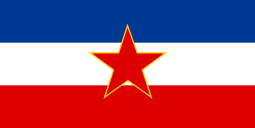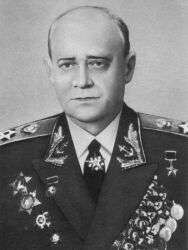Ivan Isakov
| Ivan Isakov | |
|---|---|
|
Admiral of the Fleet of the Soviet Union, Ivan Isakov | |
| Native name |
Armenian: Հովհաննես Իսակով Russian: Иван Степанович Исаков |
| Birth name | Hovhannes Ter-Isahakyan |
| Born |
22 August 1894 Hadjikend, Kars Oblast, Russian Empire |
| Died |
11 October 1967 (aged 73) Moscow, Soviet Union |
| Buried at | Novodevichy Cemetery |
| Allegiance |
|
| Service/branch |
|
| Years of service | 1917–1967 |
| Rank | Admiral of the Fleet of the Soviet Union (3 March 1955) |
| Commands held |
Chief of the Naval Staff Baltic Fleet |
| Battles/wars |
World War I Winter War World War II |
| Awards |
see below |
| Other work | The Atlas of the Sea (1947) |
Ivan Stepanovich Isakov (Armenian: Հովհաննես Իսակով, Russian: Иван Степанович Исаков; (22 August [O.S. 10 August] 1894 – 11 October 1967), born Hovhannes Ter-Isahakyan, was a Soviet Armenian military commander, Chief of Staff of the Soviet Navy, Deputy USSR Navy Minister, and held the rank of Admiral of the Fleet of the Soviet Union. He played a crucial role in shaping the Soviet Navy, particularly the Baltic and Black Sea flotillas during the Second World War. Aside from his military career, Isakov became a member and writer of the oceanographic committee of the Soviet Union Academy of Sciences in 1958 and in 1967, became an honorary member of the Armenian Soviet Socialist Republic's Academy of Sciences.[1]
Early life
Ivan Isakov was born Hovhannes Ter-Isahakyan in the family of an Armenian railway worker in the village of Hadjikend in the Kars Oblast, then a part of the Russian Empire (currently the Kars vilayet of Turkey). His father died soon after he was born. Afterward his mother raised their three children with her brother. His uncle had dreamed of service in the Navy and had a library of marine literature, which inspired an identical love of watercraft for Isakov.[2] The family later moved to Tiflis, where he studied mathematics and engineering at the local realschule, which Isakov graduated from in 1913.[1]
Military career
Early service
In 1917, Isakov moved to Petrograd, Russia, and entered the Naval Guards School of the Imperial Russian Navy and graduated as a midshipman in March of that year and briefly saw action against the Germans in West Estonian archipelago (Moonsund archipelago).[3] He continued his service after the Russian Revolution in the Baltic Sea fleet as a torpedo officer where he served on several warships including the Izyaslav, the Riga, the Kobchik and the Korshun.[1] In 1918, he took part in several battles against the German Imperial Navy until the signing of the Treaty of Brest-Litovsk, which effectively ended the war between Russia and Germany, granting the Baltic Sea to the latter. In March 1918, Isakov participated in the Ice Cruise of the Baltic Fleet from the naval base at Helsingfors where Russian warships and icebreakers were transferred from the Baltic to the naval base in Kronshtadt near Petrograd.[1] An authoritative Russian Navy source notes that Isakov completed additional courses in mine-sweeping and mine-laying in 1919 and then served in the Caspian Sea, returning to the Baltic in 1920, and subsequently serving in the Black Sea through the mid-1920s.[4]
In 1920, Isakov was transferred and assigned to the destroyer Deyatelni, which patrolled from the Volga River down to the Caspian Sea and later shelled the positions of Allied interventionist forces in the midst of the Russian Civil War. Noted for his distinction during the battles, in 1921 he was made the gun battery commander of the destroyer Izyaslav.[1] From 1922 to 1927, he served as a shtab operative, or a member of the deputy chief of staff, of naval forces in the Black Sea Fleet. In 1928, Isakov completed academic courses at the Naval Academy Leningrad and from 1930 he was Chief of Staff of the Baltic Fleet.[4] In 1932, Isakov became the professor and head of the naval art department of the Soviet Naval Military Academy and taught as a professor for five years until being promoted commander of the Baltic Fleet. From 1938-39 he headed the Naval Academy.[4] Isakov was appointed vice-commissar of naval affairs, and in 1939 he led a naval delegation to the United States with the goal of purchasing new warships from America. He met with the Secretary of the Navy, although the delegation left empty-handed, since the US was unwilling to extend aid to Soviet Russia.[5] Isakov broke away from teaching with onset of the Winter War and entered active service; he coordinated not only the movement of naval warships in the Baltic Sea but also the ground forces of the Red Army in the Soviet war against Finland.[1] From 1941-43 Isakov was the chief of the Main Maritime Staff, in 1946-47 chief of the Main Navy Staff, in 1947-1950 deputy Navy Commander-in-Chief, and in 1950-56 deputy USSR Naval Minister. From 1957 he was a member of the USSR Defense Ministry General Inspectorate.[4]
World War II
With the German invasion of the Soviet Union in 1941, the Soviet Navy's manpower drastically decreased due to a need of men to help stave off the advances made by the German armies. Nevertheless, Isakov temporarily served in the Soviet Red Banner Northern Fleet until 1942 where he became a commander in the North Caucasus Front where German forces were attempting to penetrate the oil fields of Baku. There, he was a member of the North-Caucasian Directive, a military council which planned operations and directed naval forces defending in the region. He was responsible for the successful naval landing by Soviet forces on the Kerch peninsula (the Kerch–Eltigen Operation), then held by German forces. On 4 October 1942, Isakov was injured in a German bombing raid in Tuapse and had his foot amputated, spending the remainder of the war in a field hospital. Nevertheless, Isakov continued to serve in his capacity as chief of staff of Soviet naval forces.[1]
Admiralship and scholarly work

In March 1955, Isakov was promoted to the service rank of Admiral of the Fleet of the Soviet Union, only one of three persons to ever hold that rank, but also managed to find the time for scholarly work. After becoming a professor in 1932, Isakov had spent much of his time researching military naval tactics and strategy. From 1932 to 1933, he had participated in a Soviet military report which examined German naval, particularly submarine, tactics used during battles in the First World War.[6] He received his Doktor nauk in 1937 after defending his dissertation on the routing of German forces by the Imperial Japanese Navy in the Battle of Tsingtao in 1914.[1] In 1947, Isakov was appointed editor and president of The Atlas of the Sea, a three-volume work which was, respectively, devoted to the charting of naval routes, the mapping of the seafloor and the physical landscape of the oceans, and the history of naval warfare.[1] The work went on to receive the 1951 USSR State Prize (then Stalin Prize). Other prestigious positions Isakov went on to hold was editor and adviser in the writing of the Great Soviet Encyclopedia.[1] In 1958, he became a Corresponding Member of the USSR Academy of Sciences. Isakov became a member of the Writers' Union of the USSR in 1964.
By decree of the Supreme Soviet of the Soviet Union on 7 May 1965, "For his able leadership of the troops, courage, bravery and heroism in the fight against the Nazi invaders, and in commemoration of the 20th anniversary of the victory in the Great Patriotic War," Fleet Admiral Ivan Isakov was awarded the title of Hero of the Soviet Union.[7]
Appraisal and legacy

As a naval commander, Isakov has been described by one military historian as "more a naval practitioner than a theoretician." He "emphasized that the theory of the command of the sea was a rational theory."[8]
Academician Abraham Alikhanov had written that Joseph Stalin spoke of Isakov, "A real admiral of the fleet, Comrade Isakov. Clever, no legs, but a strong head".[9]
Both the Soviet Union and Armenia have issued postage stamps dedicated to Isakov. An avenue in Yerevan is named after him.
Honours and awards
- Soviet Union
 Hero of the Soviet Union (1965)
Hero of the Soviet Union (1965) Order of Lenin, six times
Order of Lenin, six times Order of the Red Banner, three times
Order of the Red Banner, three times Order of Ushakov, 1st class, twice (№ 6–22 July 1944 and № 16–28 June 1945)
Order of Ushakov, 1st class, twice (№ 6–22 July 1944 and № 16–28 June 1945) Order of the Patriotic War, 1st class
Order of the Patriotic War, 1st class Order of the Red Star
Order of the Red Star Medal "For the Defence of Leningrad"
Medal "For the Defence of Leningrad" Medal "For the Defence of Moscow"
Medal "For the Defence of Moscow" Medal "For the Defence of Sevastopol"
Medal "For the Defence of Sevastopol" Medal "For the Defence of the Caucasus"
Medal "For the Defence of the Caucasus" Medal "For the Victory over Germany in the Great Patriotic War 1941–1945"
Medal "For the Victory over Germany in the Great Patriotic War 1941–1945" Jubilee Medal "Twenty Years of Victory in the Great Patriotic War 1941-1945"
Jubilee Medal "Twenty Years of Victory in the Great Patriotic War 1941-1945" Medal "For the Victory over Japan"
Medal "For the Victory over Japan" Jubilee Medal "XX Years of the Workers' and Peasants' Red Army"
Jubilee Medal "XX Years of the Workers' and Peasants' Red Army" Jubilee Medal "30 Years of the Soviet Army and Navy"
Jubilee Medal "30 Years of the Soviet Army and Navy" Jubilee Medal "40 Years of the Armed Forces of the USSR"
Jubilee Medal "40 Years of the Armed Forces of the USSR" Medal "In Commemoration of the 800th Anniversary of Moscow"
Medal "In Commemoration of the 800th Anniversary of Moscow" Medal "In Commemoration of the 250th Anniversary of Leningrad"
Medal "In Commemoration of the 250th Anniversary of Leningrad" Stalin Prize
Stalin Prize
- Foreign
 Order of National Liberation
Order of National Liberation Order of the Partisan Star, 1st class, twice
Order of the Partisan Star, 1st class, twice Order of the Cross of Grunwald
Order of the Cross of Grunwald
Writings
Isakov had written several books, mainly about naval warfare:[4]
- "Japanese Operations Again Tsingdao in 1914", 1936
- "USSR Naval Fleet in the Patriotic War", 1947
- "Stories About the Navy", 1962
- "The End of a Nine", 1963
- "The First Diplomatic Assignment", 1964
- "Story of an Indestructible Major", 1965
- "Naval Attractions", 1984
- "Selected Works", 1984
References
- 1 2 3 4 5 6 7 8 9 10 (Armenian) Baghdasaryan A. and Ashot H. Harutyunyan. «Իսակով, Հովհաննես Սթեփանի» (Isakov, Hovhanness Stepani). Armenian Soviet Encyclopedia. vol. iv. Yerevan: Armenian Academy of Sciences, 1978, pp. 389–390.
- ↑ Адмирал флота Советского Союза И. С. Исаков (in Russian). Flot.com. Retrieved 7 November 2013.
- ↑ Åselius, Gunnar. The Rise and Fall of the Soviet Navy in the Baltic 1921-1941. New York: Routledge, 2005, p. 203 ISBN 0-7146-5540-6.
- 1 2 3 4 5 Dotsenko, V.D. "Slovar' Biograficheskiy Morskoy" (Naval Biographical Dictionary). St. Petersburg: Logos, 2001, p.166 ISBN 5-87288-128-2.
- ↑ Polmar, Norman and Jurrien Noot. Submarines of the Russian and Soviet Navies, 1718-1990. Annapolis, Maryland: US Naval Institute Press, 1991, p. 82. ISBN 0-87021-570-1.
- ↑ Åselius. Rise and Fall of the Soviet Navy, p. 202.
- ↑ Исаков, Иван Степанович (in Russian). Warheroes.ru. Retrieved 7 November 2013.
- ↑ Армяне в "деле Лаврентия Берия" (in Russian). Noev-kovcheg.ru. Retrieved 7 November 2013.
Bibliography
- Harutyunyan, Ashot H. Սովետական Միության Նավատորմի Ծովակալ Ի.Ս. Իսակով (ռազմական ակնարկ) (Admiral of the Soviet Navy, I.S. Isakov [A Military Essay]). Yerevan: Haypethrat, 1975.
External links
- (Russian) Heroes of the Soviet Union: Ivan Stepanovich Isakov. Accessed December 28, 2006.
